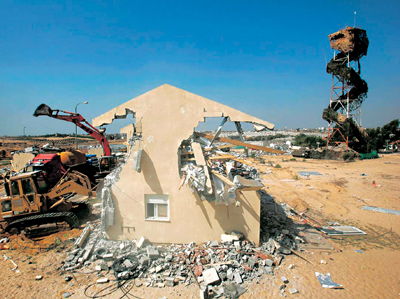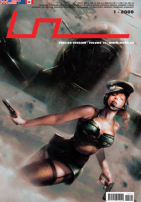| Umělec magazine 2009/1 >> Summer Camp and a Crow’s Nest | List of all editions. | ||||||||||||
|
|||||||||||||
Summer Camp and a Crow’s NestUmělec magazine 2009/101.01.2009 William Hollister | war | en cs de es |
|||||||||||||
|
Yael Bartana Videos
PS1, New York Decolonizing Architecture: Scenarios for the transformation of Israeli Settlements Bozar/NBKV gallery, Kunstraum Kreuzberg/Bethanien, Berlin. From playing suburbia to playing war When I was five, living in the finest town in New Jersey, I shared a kindergarten class drama with a friend I remember as Jerome; he was the lead actor in a role, wondering, “What am I doing in this village of sillies?” In the context, he was the only normal rational person among nut-heads, trying to come to terms with anything irrational among the rest of us. Jerome is now regally seated under azure skies in the center of Middle Eastern controversies, fiendishly, but academically calculating ways to further disenfranchise his neighbors—sillies, presumably. When I was ten, Jerome and I would play war. We’d carry sticks or squirt-guns and fight off imaginary enemies, screaming ehn-ehn-ehn-ehn to imitate the sound of machine gun fire; and we would watch the imaginary foe collapse dead in New Jersey’s autumn foliage, in impersonal agony. Somewhere along the line, we tried to get in on the Revolutionary War reenacting circuit. Once, we blew up GI-Joe action figures with July Fourth fire-crackers watching with glee as the plastic disembodied parts flung out. I grew out of it; my friend Jerome grew into it. In my twenties, I attended Jerome’s orthodox Jewish marriage to a lovely formerly Catholic girl from suburban Pennsylvania—a grand affair on the lawn of an estate once occupied by Woodrow Wilson, the architect of many a small nation and a good deal of the petty conflicts that emerged since. Footnotes were provided. Around then New Jersey suburban bliss lost its meaning. Jerome moved to Israel, and settled Palestine’s occupied West Bank—in a charming village, called Eli. It is evident that many people involved colonizing the occupied territories in the 1990s had very little to do with any promised land in the 1990s, but tended to be disaffected kiddults from places like suburban New Jersey—not far from my childhood home. The late Robert I Friedman, in Zealots for Zion (Random House, 1992), described in detail how Jerome had gone on to edit an independent neoconservative journal and had become an avid player of the ultimate suburban fantasy game, Dungeons and Dragons. “Now he is playing Napoleon on the West Bank, lording it over the Palestinians,” Friedman wrote. Supported by rich United States neo-conservative institutions, Jerome, a sometime admirer of extremist Meir Kahane, has been working diligently for a decade to build an Israeli liberal arts college that preaches Zionism and American Literature—and a form of democracy that finds necessity in excluding elements of society. According to recent Israeli newspapers, Jerome, who has founded a successful Jerusalem-based institute to propagate colonialism in Zionism’s garb, is not far from this academic objective. Moreover, Jerome is said to have ghost written the autobiography of the man who has just been appointed Israeli prime minister: Benjamin Netanyahu. Art for Engagement’s Sake At issue, here, is the manner in which visual artists use their craft in effort to intervene in a deep-seated conflict—in this case all are associated with the Middle East. I recently caught sight of two art projects working towards ends to those described in this publication, but effective in different ways. One is Yael Bartana’s video documentations, on exhibition at PS 1 in New York, curated by Klaus Biesenbach. The other is the project entitled “Decolonizing Architecture: Scenarios for the transformation of Israeli Settlements, curated by Lieven De Cauter and recently installed in association with the Islands & Ghettos project at Berlin’s NBKV gallery and Kunstraum Kreuzberg/Bethanien. As a question of engagement with a conflict whose terms are universally understood, the videos of this Israeli-born artist, and this architectural initiative, seem much more effective than others featured, if the objective is communication through dialogue. Yael Bartana watches the neighbors. At first glance Yael Bartana’s video Kings of the Hill (2003), one of five at PS1 in New York, seems like documentation southern California beach scene. Expensive American all terrain vehicles skid up and down seaside hills, smashing through sand dunes, turning corners and spinning tires. The men drive, and shawl-covered wives observe from a safe distance. There does not seem to be any top, and there seems to be nothing to go to. But it isn’t America; it’s Israel, and it’s the Mediterranean Sea and the men are not kings. As Sergio Edelsztein writes in the the exhibition catalogue, “the conquering ‘kings’ are, in fact, lower middle class plumbers and contractors who own SUVs only because of a tax break.” What is noteworthy is that these SUV drivers are, as Israeli citizens, current or former conscripted soldiers of that country’s army. In that capacity, they’d be “cut from the same cloth” as the men who smash tractors into the side of Palestinian homes. The policy of destroying the homes of people related to suicide bombers has long been a strategy of the Israeli army. Such tractors are seen driving away from the rubble of one such building, in Bartana’s Summer Camp (2007). This short film documents a group of people—international, Palestinians and Israelis—who have taken it upon themselves to rectify the injustice of collective punishment, and help rebuild such Palestinian homes. What is remarkable is not so much the mundane drama of peace and justice activists pouring concrete and placing cinder blocks; the film is presented juxtaposed with another one, one with very similar motifs, but of a very different nature: It is the 1935 Israeli propaganda film, Avodah, made by Hungarian Helmar Lerski, shows early Israeli settlers building the new Israel, harvesting the land, harnessing the rivers, assembling the building blocks of a future nation. Music in the background heard for both films shown simultaneously on opposite sides of the same screen in the middle of a cedar paneled room. The film is dramatic with film angles taken right from Eisenstein, and starkly reminiscent of Riefenstahl. The grand, sculptural figures of the moment are contrasted sharply with the jean-and t-shirt clad activists, albeit with no lesser sense of mission: that of creating a space for justice and co-existence to evolve. A linking video, Low Relief II, (2004) simply presents the images of activists, raised to the epic quality endowed by Babylonian wall sculpture—but in the genre of video. This simple film trick contrasts with the very human drama of some 18-year-old Israeli pacifists filmed by Bartana playing a game called the “Evacuation of Gilad’s Colony.” The action reenacts as child’s play Israel’s forced removal of Jewish settlers from the Occupied Territories. Where resistors tried to escape.Against a dramatic Palestine background, the participants would resist and break away from two of their own teammates who had volunteered to act as “authorities.” The game’s players’ language duplicated the actual words used by the evacuated settlers. In Trembling Time (2001) one again imagines watching a scene in America, a western highway, as automobiles seen at night from an overpass, come slowly to a halt. People step out of their cars and simply stand, silently, then continue. It is in Tel Aviv, and the people are remembering the war-dead of all previous Israeli military conflicts; in doing so, they are reinforcing a narrative of militarism in daily Israeli life. Bartana, in effect, is bringing out the rage of Caliban at seeing his face in a mirror, and observing whether there might be reaction of anger, or if people could be energized to change. In a statement presented about this film when shown at the Prague Biennale, Bartana explained, “I am focusing on Israel in order to ask: what is this place where I grew up? How long will this troubled nation continue to perpetuate this pattern of ignorance? By manipulating form, sound and movement, I create work that triggers personal resonance. Intimate reactions have the potential to provoke honest responses and perhaps replace the predictable, controlled reactions encouraged by the state” In the Shadow of the Crow’s Nest. A former military base near Bethlehem in the occupied West Bank is called Oush Grab, which translates to “Crow’s Nest.” It is now one of the settings for a project involving the London/Bethlehem architectural studio of Sandi Hilal, Alessandro Petti and Eyal Weizman. The project Decolonizing Architecture attempts to “articulate a process.” Indeed, the associated projects are all speculative, but in their presentation, have encouraged with challenging, if comic ideas, ways for participants to engage with each other. The groups involved are studying what happens to locations where occupying forces have withdrawn, and various power vacuums have evolved over abandoned bases and towns. “Whatever trajectory the conflict over Palestine takes, the possibility of further partial-or-complete evacuation of Israeli colonies and military bases must be considered,” the group’s online statement at decolonizing.ps explains. “Zones of Palestine that have or will be liberated from direct Israeli presence provide a crucial laboratory to study the multiple ways in which we could imagine the reuse, re-inhabitation or recycling of the architecture of Israel’s occupation at the moment this architecture is unplugged from the military/political power that charged it.” Of all the projects explored by decolonizing Architecture at Berlin’s Bethanian, the case of Oush Grab is most encapsulating. The Israeli army departed from the small hilltop base shortly after the Oslo peace accord, But in 2008 a group of settlers attempted to build a settlement outpost on the site, they returned regularly holding picnics, tours and Torah lessons all accompanied by the Israeli flag, and protected. In intermittent moments, Palestinian and international activists also occupied the site in intermittent revolving door occupations, overlapping graffiti indicates whichever faction was last able to get onto the hill As an initial proposal for the base, the architectural firm has proposed a program of “creative destruction.” Holes would be drilled into the concrete military structures, transforming the landscape and to partially bury some of the buildings. The results of interaction with residents closest to the location and NGOs including the Palestinian Wildlife Society, Women’s Shelter and Alternative Tourism Group, were greeted with amusement. “In the beginning we feared we were ridiculed,” the architects write. “Were our plans too far fetched and outlandish within this environment of permanent impossibility… the smile we noticed may be the first moment of decolonization.” On the Ground When I visited Israel years ago, a man my father was working with, a hero in the Six day War and a local scientist, stoically identified his friends on a war monument in a moment, after showing us crusader castles, Paleolithic campfires and how the Israelis were making a nuclear device. He also brought us by a refugee camp near Jericho. As we looked at all the dust and detritus of lives displaced by the Six Day War, he remarked, “You know? We made all these people refugees, they will have children, they will grow up, and they will still want to go home.” It is always interesting to hear what is said by people closest to conflict zones. Within the genre of this publication, there is a multiplicity of expressions about war, about the desire for peace, albeit somewhat short-changing of justice. As concerns Middle Eastern conflicts, these to presentations—the endeavors of Yael Bartana and the Decolonizing Architecture project—represent proposals of ways to work with visual culture, specifically to improve society. Their task is all the more difficult when the obstacle to these efforts is played out by with whom I played, in my own back yard, on the nicest of lawns.
01.01.2009
Recommended articles
|
|||||||||||||















Comments
There are currently no comments.Add new comment